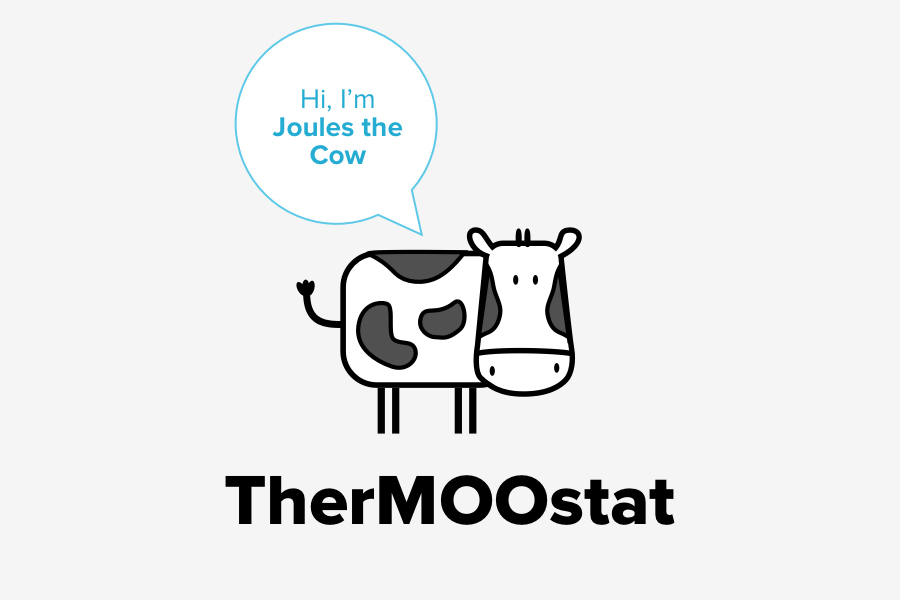
UC Davis web application works to increase comfort, reduce energy waste
Since the fall of 2014, the Energy Conservation Office at UC Davis has had a tile on the myUCDavis site for its web application TherMOOstat. Students, faculty, staff and guests are able to submit comments through TherMOOstat about how rooms on campus feel — hot, warm, perfect, chilly, or cold — in order to help the ECO crowdsource comfort on campus while keeping energy costs down.
When submitting a comment through TherMOOstat, the ECO asks about the building, room number, current comfort, level of clothing and amount of physical activity performed in the last 10 minutes.The team’s mascot, Joules the Cow, is eager to assist.
“We’re excited to be able to use all of this great crowdsourced data that everyone is submitting and put it to good use,” said Kiernan Salmon, a data analyst and product developer at the ECO. “We’re able to tailor the project that we’re doing in this office to what people need.”
Managing the temperatures of a large campus is like managing a city, said John Coon, the energy project manager at the ECO. Some of the challenges are due to the diverse accomodations found in a university. Undergraduate students might be most familiar with lecture halls and classrooms, but full-time staff members may work all day in an office, while graduate students could be spending long days in a specialized laboratory. Each room has unique ventilation requirements
“We’ve got over 1,000 buildings on campus,” Coon said. “Some of the buildings have temperature control systems, so that we can see what the major equipment and what the major conditions are inside the buildings.”
Some buildings, due to age or design, are not completely visible with the remote tools used by the staff at the ECO or Facilities Management, the group which responds to submitted work orders. Haring Hall and the Memorial Union are two such structures, receiving the most comments so far this quarter, at 74 and 67, respectively. Most comments claim the buildings are too hot, but in previous quarters, most felt the buildings were too cold.
“We receive, on average, about 300 [comments] a month,” Salmon said. “One of the trends that we see is, when the seasons are changing, the number of votes we get goes way up. For us, March and April, our big months, could have 500 to 600 [comments]. October and November, when it starts to get colder outside, those are big months for us, 500 to 600 again. It fluctuates a lot in the summer, when students aren’t here.”
Every comment submitted through the TherMOOstat system is manually reviewed and investigated.
“When we get a comment, or feedback, in from TherMOOstat, I’ll take a look at it,” Coon said. “I’ll take a look at the timestamp and the building and which room they’re in, and first determine whether or not I can see anything because there are buildings on campus I can’t see at all.”
Coon is able to see what most buildings and rooms are being used for on campus at a given time. A single complaint of chilly temperature in a lecture hall of 300 students may not set off alarm bells or send a team in to rush a work order, but will be considered for historical trends.
“We take the feedback and we use it to inform future decisions,” Coon said. “There’s not much relief we can offer immediately.”
Properly controlling temperatures in campus buildings can help reduce the energy usage and expenditures on campus, as detailed in a short educational program created by the ECO.
“We have a Trim the Waste program, a four-part series where people learn a bit about how the campus uses energy,” Salmon said. “Then we show them the factors that influence how much energy each building uses.”
Energy usage, as well as the type of energy used, can have important economic impacts at UC Davis. Carrie Chung is a fourth-year communication major serving as a communications intern at the ECO. One of her roles involves crafting blog posts to share new insights to the public — including how much energy and money UC Davis saved by changing heating and cooling tendencies over breaks.
“Over the holidays, when there’s nobody here in certain buildings, we just shut those buildings off completely and turn off all heating, cooling, and lighting,” Chung said. “This saves us thousands of dollars.”
The TherMOOstat system may not be an automatic temperature control system for the thousands of students, faculty, staff and guests who work together as campus “roommates”, but by collecting information about how people feel in their rooms and buildings, the ECO is able to help increase personal comfort, reduce energy costs and educate the public about energy usage.
“We try and let people know how their building works, so they get a better idea of what they can do on their end and what we can do on our end,” Salmon said. “It’s more of a discussion that way.”
Written by: George Ugartemendia — science@theaggie.org



